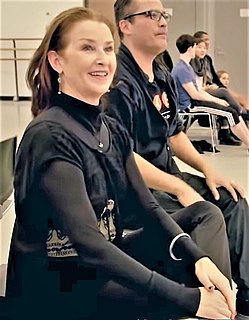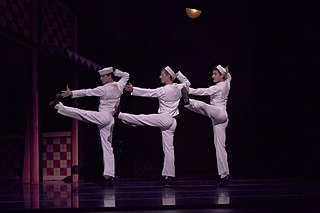
Darci Kistler is an American ballerina. She is often said to be the last muse for choreographer George Balanchine.
Willam Farr Christensen was an American ballet dancer, choreographer and founder of the San Francisco Ballet and Ballet West in Salt Lake City, Utah. He is known for bringing the complete version of the Russian ballet The Nutcracker to the United States, as well as staging the first American performances of Swan Lake and Coppélia. Christensen's Nutcracker was first staged in 1944 in San Francisco, where the ballet remains an annual tradition, though the production now staged there is not necessarily the Christensen version. Christensen is often credited with helping to rejuvenate American dance.
Le Baiser de la fée is a ballet in one act and four scenes composed by Igor Stravinsky in 1928 and revised in 1950 for George Balanchine and the New York City Ballet. Based on Hans Christian Andersen's short story Isjomfruen, the work is an homage to Pyotr Ilyich Tchaikovsky, for the 35th anniversary of the composer's death. Stravinsky elaborated several melodies from early piano pieces and songs by Tchaikovsky in his score. A commission by Ida Rubinstein from 1927, the ballet was choreographed by Bronislava Nijinska and premiered in Paris on 27 November 1928.

The company Ballets Russes de Monte-Carlo was formed in 1932 after the death of Sergei Diaghilev and the demise of Ballets Russes. Its director was Wassily de Basil, and its artistic director was René Blum. They fell out in 1936 and the company split. The part which de Basil retained went through two name changes before becoming the Original Ballet Russe. Blum founded Les Ballets de Monte Carlo, which changed its name to Ballet Russe de Monte-Carlo when Léonide Massine became artistic director in 1938. It operated under this name until it disbanded some 20 years later.
Jewels is a three-act ballet created for the New York City Ballet by co-founder and founding choreographer George Balanchine. It premièred on Thursday, 13 April 1967 at the New York State Theater, with sets designed by Peter Harvey and lighting by Ronald Bates.

Apollo is a neoclassical ballet in two tableaux composed between 1927 and 1928 by Igor Stravinsky. It was choreographed in 1928 by twenty-four-year-old George Balanchine, with the composer contributing the libretto. The scenery and costumes were designed by André Bauchant, with new costumes by Coco Chanel in 1929. The scenery was executed by Alexander Shervashidze, with costumes under the direction of Mme. A. Youkine. The American patron of the arts Elizabeth Sprague Coolidge had commissioned the ballet in 1927 for a festival of contemporary music to be held the following year at the Library of Congress in Washington, D.C.
John Taras was an American ballet master, repetiteur, and choreographer.
Backchat is a ballet made by Eliot Feld for his Ballet Tech company to "Idle Chatter Junior" by Paul Lansky. The premiere took place October 21, 2004, during the company's MANDANCE PROJECT season at the Joyce Theater, New York. The New York City Ballet premiere of Backchat was Saturday, April 29, 2006, at the New York State Theater, Lincoln Center.
Bayou is a ballet made by New York City Ballet's co-founder and ballet master George Balanchine to Virgil Thomson's Acadian Songs and Dances (1947). The premiere took place on 21 February 1952 at City Center of Music and Drama, New York.
Tango is a ballet made by New York City Ballet co-founder and founding choreographer George Balanchine to Stravinsky's Tango (1940) arranged 1953 by the composer. The premiere took place June 10, 1982, as part of City Ballet's Stravinsky Centennial Celebration at the New York State Theater, Lincoln Center.
Zakouski is a ballet made by New York City Ballet ballet master in chief Peter Martins to:
Octet is a ballet made on New York City Ballet by Willam Christensen to Stravinsky's Octet for Wind Instruments (1922–23). The premiere took place December 2, 1958, at the City Center of Music and Drama.
The ZenobiaPas de Deux is a ballet made by George Balanchine, subsequently co-founder and founding choreographer of the New York City Ballet for Richard Rodgers's 1936 musical On Your Toes, in which it was performed under the title La Princesse Zenobia Ballet. Balanchine parodies such Oriental-style ballets as Schéhérazade. The City Ballet premiere took place on Tuesday, November 23, 1993, at the New York State Theater, Lincoln Center.
Eight Lines is a work by American minimalist composer Steve Reich which was originally titled Octet.

Fancy Free is a ballet by Jerome Robbins, subsequently ballet master of New York City Ballet, made on Ballet Theatre, predecessor of American Ballet Theatre, to a score by Leonard Bernstein, with scenery by Oliver Smith, costumes by Kermit Love and lighting by Ronald Bates. The premiere took place on Tuesday, 18 April 1944 at the old Metropolitan Opera House, New York. The NYCB premiere took place Thursday, 31 January 1980. Fancy Free was the inspiration for a successful musical, On the Town, and a portion of the score was also used in the opening scenes of Alfred Hitchcock's Rear Window.
Bugaku is a ballet made by New York City Ballet co-founder and ballet master George Balanchine to eponymous music by Toshiro Mayuzumi, commissioned by City Ballet in 1962. The premiere took place on 30 March 1963 at City Center of Music and Drama, New York, with scenery by David Hays, costumes by Karinska, and lighting by Ronald Bates. NYCB had toured Japan in 1958 and the Gagaku Company of the Imperial Household toured the US the following year.
Mother Goose is a ballet made for New York City Ballet's Ravel Festival by balletmaster Jerome Robbins to Ravel's music and scenario, the Ma Mère l'Oye Suite from 1908, orchestrated by the composer in 1912. The premiere took place on May 22, 1975, at the New York State Theater, Lincoln Center, with costumes by Stanley Simmons and lighting by Jennifer Tipton. At its premiere it bore the French title, which was retained when it was first revived in January 1978 but anglicized by May of that year.
Ma Mère l'Oye was written as a suite of five pieces for piano four hands and later orchestrated and adapted into a ballet, by M. Ravel, with the addition of a prelude, an opening scene and four interludes connecting the five original pieces.
Tschaikovsky Piano Concerto No. 2, originally called Ballet Imperial, is a ballet in three movements made by New York City Ballet's co-founder and founding choreographer George Balanchine for his earlier company, American Ballet Caravan, to the version of Peter Ilyitch Tchaikovsky's Piano Concerto No. 2, originally composed in 1879–80, but later revised by Alexander Siloti. The ballet was given a preview performance on 29 May 1941 at the Little Theater of Hunter College in New York City. The premiere took place on 25 June 1941 at Teatro Municipal, Rio de Janeiro.
Who Cares? is a ballet made by New York City Ballet's co-founder and founding choreographer George Balanchine to songs by George Gershwin in an orchestration by Hershy Kay. The premiere took place on Saturday, February 7, 1970, at the New York State Theater, Lincoln Center with costumes by Barbara Karinska and lighting by Ronald Bates; it was at first performed without décor but from November 1970 with scenery by Jo Mielziner.